
Amanita muscaria, commonly known as the fly agaric or fly amanita, is a basidiomycete of the genus Amanita. It is a large white-gilled, white-spotted, and usually red mushroom.

The genus Amanita contains about 600 species of agarics, including some of the most toxic known mushrooms found worldwide, as well as some well-regarded edible species. The genus is responsible for approximately 95% of fatalities resulting from mushroom poisoning, with the death cap accounting for about 50% on its own. The most potent toxin present in these mushrooms is α-Amanitin.

Amanita pantherina, also known as the panther cap, false blusher, and the panther amanita due to its similarity to the true blusher, is a species of fungus found in Eurasia with poisonous and psychoactive properties.
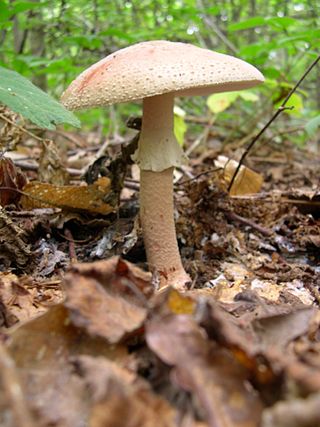
The blusher is the common name for several closely related species of the genus Amanita. A. rubescens, or the blushing amanita, is found in Europe and eastern North America, and A. novinupta, also known as the new bride blushing amanita, is found in western North America. Both their scientific and common names are derived from the propensity of their flesh to turn pink upon bruising or cutting.
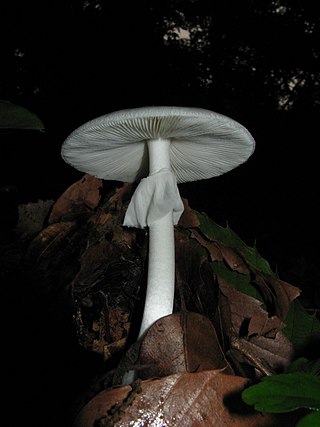
Amanita verna, commonly known as the fool's mushroom or the spring destroying angel, is a deadly poisonous basidiomycete fungus, one of many in the genus Amanita. Occurring in Europe in spring, A. verna associates with various deciduous and coniferous trees. The caps, stipes and gills are all white in colour.

Amavadin is a vanadium-containing anion found in three species of poisonous Amanita mushrooms: A. muscaria, A. regalis, and A. velatipes. Amavadin was first isolated and identified in 1972 by Kneifel and Bayer. This anion, which appears as a blue solution, is an eight-coordinate vanadium complex. A Ca2+ cation is often used to crystallize amavadin to obtain a good quality X-ray diffraction. Oxidized amavadin can be isolated as its PPh4+ salt. The oxidized form contains vanadium(V), which can be used to obtain an NMR spectrum.
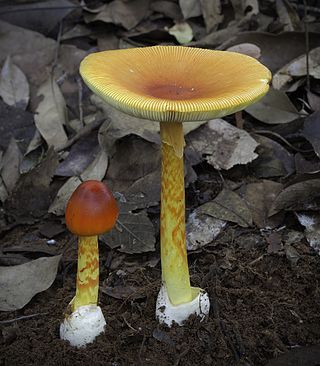
Amanita hemibapha, commonly known as the half-dyed slender Caesar, is a species of agaric found in southeast Asia and Oceania, although some distribution reports may refer to different taxa.

Amanita albocreata, also called the ringless panther or the ringless panther amanita, is a species of fungus in the family Amanitaceae. It was discovered in 1944, by William Murrill. It is commonly found in the northeastern United States and parts of southeastern Canada. It normally grows between the rainy months of June and August.

Amanita battarrae, also known as the grey-zoned ringless amanita, is a species of Amanita found in Italy in the fall as well as in eastern Europe.
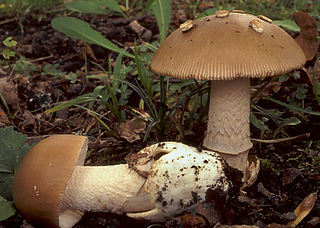
Amanita lividopallescens, also known as the pale amanita, is a species of Amanita in Europe that grows near oaks.
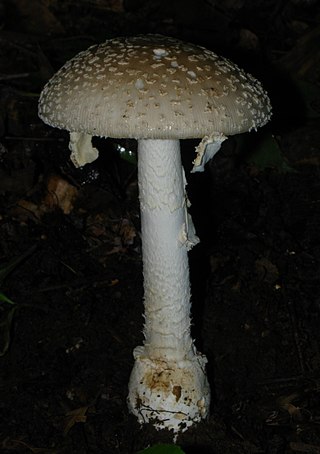
Amanita multisquamosa or the small funnel-veil amanita is a species of Amanita from the coniferous forest of eastern North America.

Amanita brunneolocularis, also known as the Mesoamerican dark volva blusher, is an uncommon species of Amanita.

Amanita proxima is a species of Amanita from France, Italy, and Spain. It is poisonous.

Amanita solaniolens or old potato amanita is a species of Amanita from Nova Scotia, Canada.

Amanita elongata or Peck's yellow dust amanita is a species of Amanita from Northeastern United States and Canada.

Amanita polypyramis is a species of Amanita found in the Eastern United States. It is a large, bone white mushroom with a chlorine-like odor. Its species name, polypyramis, refers to the pyramid-like warts on the surface of the pileus (cap).

Amanita calyptratoides, or Peck's candlestick amanita, is a species of Amanita found in southern California

Amanita carneiphylla is a species of Amanita found in Western Australia growing among Eucalyptus, Banksia, and Allocasuarina

Amanita betulae is a species of Amanita found in growing in birch and mixed hardwood in Europe























